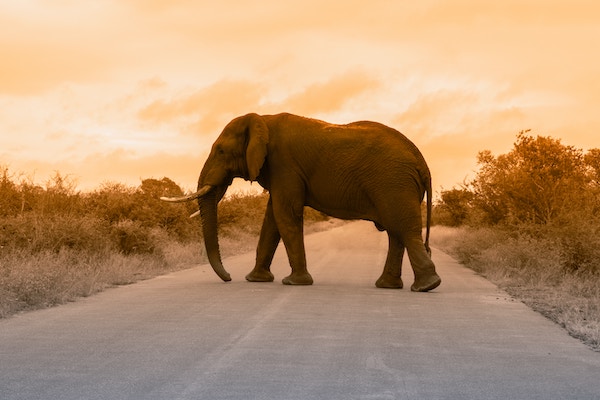Endangered Animals on a Map
What do the Black Rhino, Amur Leopard, and Sumatran Orangutan all have in common? Though they live on different continents, they’re all considered to be “Critically Endangered.” Along with 14 other species, these three animals have a conservation status that is closest to extinction according to the World Wildlife Fund. Explore the map below to see 90 endangered animals and where you can find them. Then, read on to see what each status means and the most common types of animals on the list.
View Endangered Animals Mapped in a full screen map
You can sort the map by the color-coded conservation statuses. Red refers to animals that are “Critically Endangered,” orange is for “Endangered” animals and yellow signifies animals that are “Vulnerable.” Species that are “Near Threatened” are shown in green whereas animals that can be classified as “Least Concern” appear blue on our map.
Conservation Status: What Does Endangered Really Mean?
According to the World Wildlife Fund (WWF) where we got the data for our map, there are five different conservation statuses that are cause for concern. The table below explains the types of conservation statuses ordered from least concerning to the status with the greatest cause for concern.
| Conservation Status | Meaning |
|---|---|
| Least Concern | Doesn’t qualify for any of the other conservation statuses. |
| Near Threatened | Will probably qualify for a more concerning conservation status soon. |
| Vulnerable | Faces a high risk of extinction in the wild. |
| Endangered | Faces a high risk of extinction in the wild. |
| Critically Endangered | Faces an extremely high risk of extinction in the wild. |
Critically Endangered, Endangered, and Vulnerable
Interactive Maps Made Easy
Sign Up NowAll of the conservation statuses on the map are important. However, the term “endangered” specifically refers to animals that are either “Critically Endangered,” “Endangered,” or “Vulnerable.” There are 18 “Critically Endangered” animals out of the 90 that we mapped. Some of these animals include the Saola, Vaquita, and the Yangtze Finless Porpoise, along with 15 others. There are also 30 “Endangered” animals on the map, such as the African Wild Dog, the Black-footed Ferret, and the Poison Dart Frog. Finally, there are 20 animals that maintain a “Vulnerable” conservation status, like hippos, the Black Spider Monkey, the Marine Iguana, and 17 more.
Near Threatened, Least Concern, and Others
Our map also contains ten “Near Threatened” animals and 11 “Least Concern” animals. Some of the animals that are “Near Threatened” are Jaguars, Monarch Butterflies, and the Plains Bison. The “Least Concern” animals on our map include Arctic Wolves and Tree Kangaroos.
There are three additional statuses the WWF sometimes uses to categorize animals that are not on the map. Two of these statuses indicate very few remaining animals or that they have disappeared from the face of the Earth entirely. “Functionally Extinct” or “Extinct in the Wild” animals exist only in captivity; they can no longer be found in the wild. With “Extinct” animals, the name speaks for itself. Scientists and classify an animal as “Extinct” when they’re sure the last known animal of the species has died. The third additional conservation status is “Data Deficient.” These animals don’t have enough data for us to know how many still exist. Orca Whales are “Data Deficient,” perhaps because scientists aren’t too excited about the dangers of tagging a Killer Whale.
Animals with Multiple Sub-Species on the Decline

The following animals are facing the decline of multiple sub-species:
- Elephants
- Tigers
- Whales & Dolphins
- Rhinos
- Turtles & Tunas
- Gorillas & Orangutans
- Leopards
- Sloths
- Penguins
- Pandas & Bears
- Sharks
- Foxs
That’s 16 animal types with two or more sub-species needing a conservation classification! Here’s a breakdown of these animals and their sub-species. “Critically Endangered” animal subspecies — animals currently facing an extremely high risk of extinction in the wild — include the Amur Leopard and three different sub-species of rhinos. The Black Rhino, Javan Rhino, and the Sumatran Rhino are all “Critically Endangered.” Two types of orangutans are also “Critically Endangered:” the Bornean Orangutan and the Sumatran Orangutan. Further “Critically Endangered” animals include three types of gorillas: the Cross River Gorilla, the Eastern Lowland Gorilla, and the Western Lowland Gorilla. The Hawksbill Turtle is also “Critically Endangered,” as is the Pygmy Three-toed Sloth and the Sumatran Elephant. Two species of tigers are also “Critically Endangered:” the Malayan Tiger and the Sumatran Tiger.

“Endangered” animals facing high risks of extinction in the wild include four species of elephants: Asian, Borneo Pygmy, Indian, and Sri Lankan. There are four types of “Endangered” whales: Blue, Fin, North Atlantic Right, and Sei. Many sub-species of dolphins are also “Endangered,” including Ganges River, Hector’s, Indus River, and Irrawaddy Dolphins. Plus, Amur, Bengal, and Indochinese Tigers all face endangerment.
As for “Vulnerable” animal sub-species, we count three elephants, three turtles, and one dolphin. African, Forest, and Savanna Elephants all have “Vulnerable-status.” They face high risks of extinction in the wild, as do Leatherback, Loggerhead, and Olive Ridley Turtles and Amazon River Dolphins. Bigeye Tuna, Giant Pandas, Greater One-Horned Rhinos, Polar Bears, Maned Sloths, and Snow Leopards are also “Vulnerable.”
 This Endangered Animals Map was made with BatchGeo, and you can make similar maps using your own data!
This Endangered Animals Map was made with BatchGeo, and you can make similar maps using your own data!
BatchGeo offers a map grouping feature, which is a great way to pinpoint trends within your data you may have missed otherwise. For example, once we grouped our map by Conservation status, we noticed that many Critically Endangered animals are located in Sumatra. The ability to sort any map by type or group will almost always provide new insights, as is the option to change the color of your grouping markers. Plus, you can customize your map’s markers to one of three shapes as we utilized in our map.
